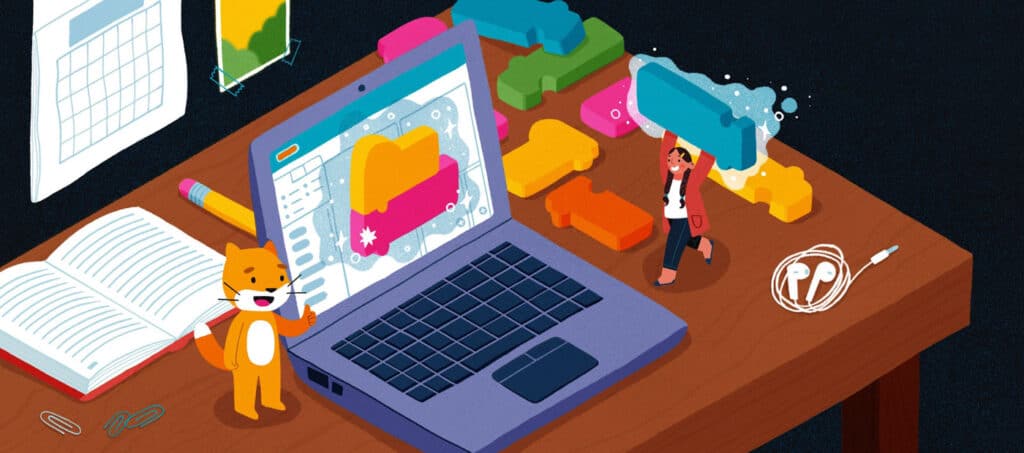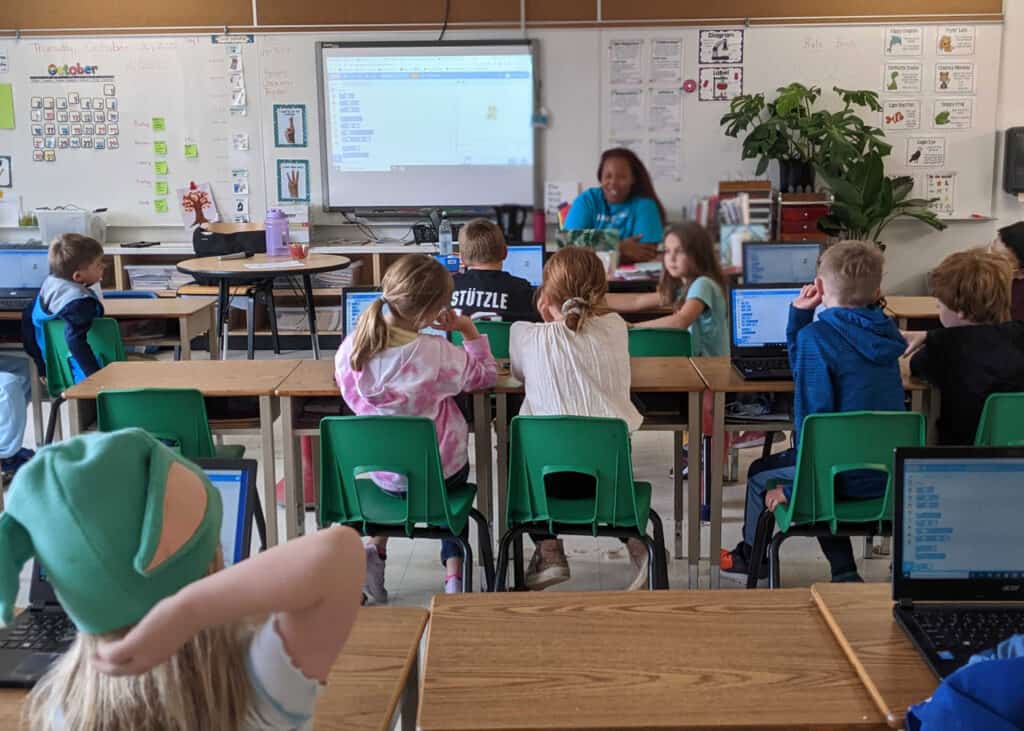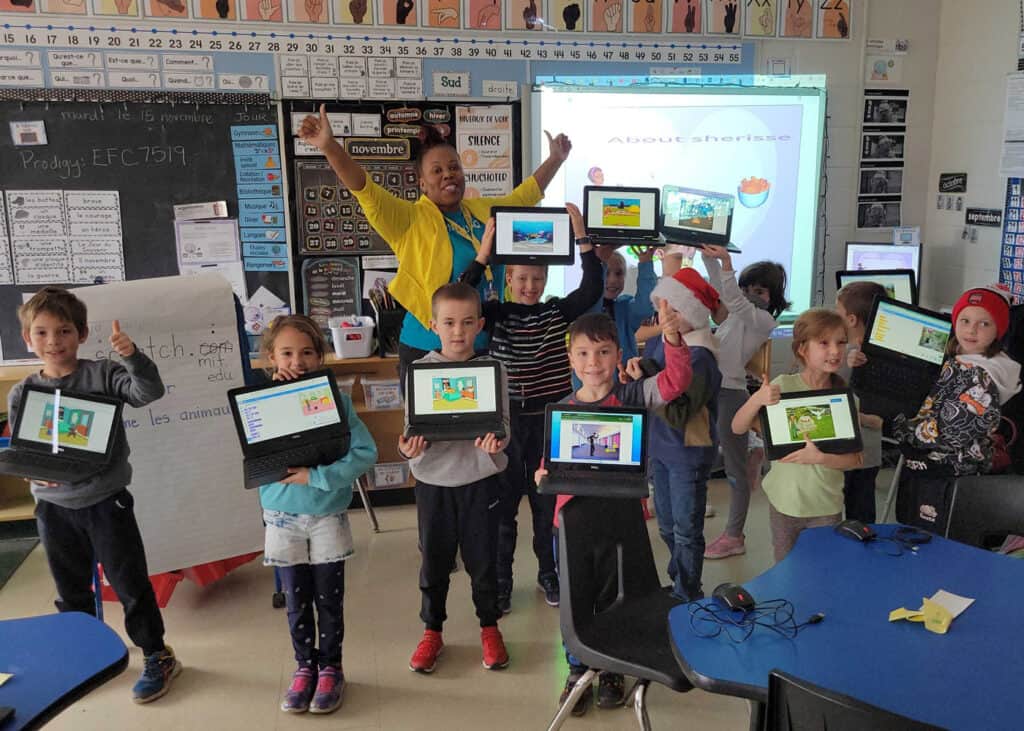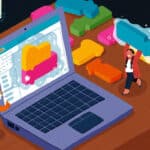With Sherisse Richards
By Chelsea Kowalski
Scratch, a programming language, has become an increasingly popular classroom tool that helps students learn to code, think creatively, and reason logically. Created by the Scratch Foundation, the software uses basic coding principles to allow users to create animated stories, games, and more. Pinnguaq’s own Sherisse Richards, a senior digital skills educator, spoke with Root & STEM about community efforts to bring Scratch to classrooms all over the world.

What is Scratch and how can it be useful for educators?
In the words of Scratch’s co-founder, Mitch Resnick, “Scratch is a programming language and an online community.” It’s wonderful because it allows for the creation of animations, interactive stories, and games, and uses a block coding structure. And it really affords users of all ages the opportunity not only to think systematically but also to collaborate creatively, to really stretch their imaginations and do so many wonderful things. It’s 100 per cent free and open-source. It’s used in about 200 countries in more than 70+ languages. Primarily, they say it’s targeted toward the ages of 8 to 16 but there’s also a ScratchJr for those who are even younger.
I’m super, super enthusiastic about Scratch. It’s one of my favourite platforms because it allows for that interactive storytelling element but also gives educators the opportunity to play with their students. I was told that the word scratch actually comes from the way disc jockeys would scratch on the turntable. Scratch has that wonderful element of collaboration where you can remix existing Scratch material. It’s very useful for educators who are looking to teach their students fun ways of learning programming literacy while supporting the use of imagination.
For educators with no Scratch experience, what’s the best way to learn?
For people with absolutely zero knowledge base, there’s great news: that’s OK. You don’t need any prior experience. I would even go as far as to say it’s a confidence booster. You don’t have to come in knowing any particular programming language. It’s just like LEGO®. You snap the puzzle pieces together and that creates your story. Each command or code block is like a puzzle piece. As you snap them together, the story is told and then you press a green flag, and your story comes to life. Your character starts doing what those little puzzle pieces told it to do. So many people can play with puzzles, right? That’s the beautiful thing. Because Scratch is all about play, you can just play.
For Scratch users who need support, what resources are available?
There are a lot of different ways that you can get support and learn to utilize the platform. The Scratch Foundation provides first-hand resources to people who are a member or to the partners of the Scratch Education Collaborative.
Pinnguaq has an amazing resource called “Literacy through Scratch Story Games—Teacher’s Guide” that we made in partnership with Ilitaqsiniq. There are so many different online resources that you can reference for help, but the teacher’s guide puts everything right there for you. It discusses Scratch as a learning tool and goes over the basics. For example, it covers the project stage where your character—called a sprite—is formed, as well as how you can access various backgrounds and the different block commands to get your sprite to look a certain way. Then you’ll learn about the coding area, where you can put all those puzzle pieces together to tell a story. It’s an amazing resource I highly recommend to educators. This is something that I can see there’s a need for in so many different communities
Why is Scratch in particular useful for educators focused on bringing inclusive and accessible tools to their classroom?

We all know that there are a lot of barriers that exist with regards to education, and especially with regards to technology. That’s the beauty of Scratch. Just in terms of its design, there are so many different things that allow learners to utilize the platform. There’s a downloadable app that you can use, which is especially helpful for people who sometimes don’t have access to the internet or who feel the impact of the digital divide.
Once you start Scratching, it’s very easy to get hooked. People sometimes have a preconceived notion of what skills they believe they need to have prior to utilizing many platforms. But the great thing about Scratch is that they have something called guiding principles. If you think of Scratch as a room, they have low floors, wide walls, and high ceilings. Low floors represent that it’s easy to use and climb; there’s no real barriers there for you. Wide walls represent vast room for creation. So in terms of games, animations, or interactive stories, you can conceptualize and create things that are out of this world. Lastly, high ceilings represent the ability to create complex projects. So in terms of affordances, Scratch meets you where you’re at.
The Scratch Foundation is awesome. They partner with various organizations, such as Pinnguaq, to find out what some of those barriers are that we see first hand. They really take into account the voice of the community. Inclusivity is oftentimes a barrier because people may not want to participate if they don’t feel well represented. But in Scratch, you can overcome that by creating your own sprite that is reflective of who you are in your story. It’s equitable. Oftentimes in underrepresented communities, especially Indigenous communities, there are so many rich stories or oral traditions that we see. Scratch affords us a medium to tell those stories while being part of the learning experience.
What about in areas of education that are often overlooked, or underrepresented? Do you think that Scratch reaches those areas?
The Scratch Foundation is awesome. They partner with various organizations, such as Pinnguaq, to find out what some of those barriers are that we see first hand. They really take into account the voice of the community. Inclusivity is oftentimes a barrier because people may not want to participate if they don’t feel well represented. But in Scratch, you can overcome that by creating your own sprite that is reflective of who you are in your story. It’s equitable. Oftentimes in underrepresented communities, especially Indigenous communities, there are so many rich stories or oral traditions that we see. Scratch affords us a medium to tell those stories while being part of the learning experience.
How does a programming language for coding help support literacy and language development
This is also where our teacher’s guide can come in handy. It does a great job of explaining how Scratch is a language tool in regard to digital literacy. It was actually created with a purpose to help teachers use Scratch for language literacy and conservation. There are different types of languages and programming languages, and Scratch really allows students to write their story games in any language, and with any writing system, including syllabics.
Additionally, video games created by users in their language can then be used to teach others. These games are created by the community for the community. There are so many times I see learners who get so enthusiastic because not only do they feel represented, but they’re also able to use a platform that really is inclusive of their culture or their story. It’s a powerful thing to see someone’s face light up when they feel that their story matters—because it does.
There is also the Inuktitut Digital Literacy Game Engine. It’s a host of three games, for which we partnered with Ilitaqsiniq, that focuses on teaching Inuktitut. There’s a syllabic matching game where users match words with sprites (images of animals in this case); the syllabic spotter games, where the user must guide a narwhal to the right syllabic characters; and animal game announcer, where students can practice their pronunciation. These are examples of how learners can actually use these platforms in creative ways, where they can make meaningful connections to things that are relevant to their world.
Any advice for people who want to try Scratch after reading this?
My advice for anyone who wants to utilize Scratch for the first time is: Just do it! Just jump in the Scratch pool. And don’t worry about making mistakes. As I said, the wonderful thing about Scratch is, there’s no wrong way of doing something. Just try it. Don’t be afraid of anything. There’s nothing wasted when you’re Scratching.
You may think, “I’m just one person.” Maybe I just love to play video games or teach or learn. But you don’t realize that Scratch is a puzzle with pieces coming together in order to create a beautiful story and people have that same connectivity. Connectivity in terms of our goals and purposes. We all want to be able to feel included, to learn, and to matter. So the thing that I can say is just go ahead and start. There’s nothing to lose and so much to gain.
The STEAM Makers section of Root & STEM showcases the different ways educators engage with students and promote STEAM concepts in and out of the classroom. If you know of an educator who goes the extra mile, tell us about them at STEAM@pinnguaq.com.


